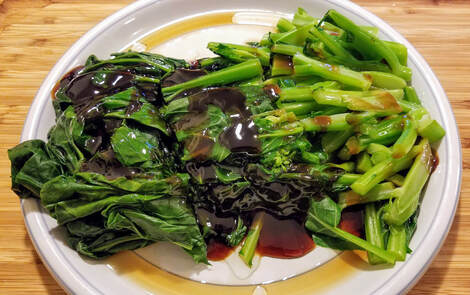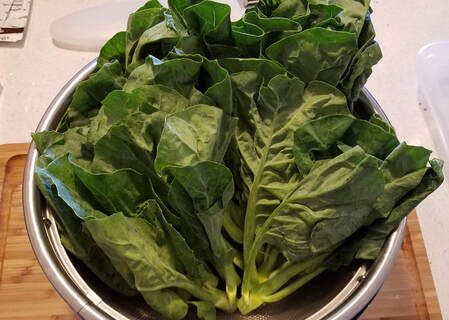So what does Coronavirus have to do with Chinese Broccoli you may be wondering? Well, as long as everyone is eager to become the captain of their kitchen and until we can freely socialize again, I’m going to encourage you to keep trying new foods, and especially new vegetables. While many asian vegetables can be hard to find in your local Safeway or Kroger, a growing exception is Chinese Broccoli. This hearty green vegetable is becoming readily available in most supermarkets and is a delicious, easy to prepare way to get your 5-a-day. So while we're all stuck indoors, why not try out something new while you have the extra time?
Let’s dive in.
Chinese Broccoli (also known as Gai Lan) is in fact related to the classic Western broccoli we all know and love. While it may not look like it, they are different cultivars of the same species - Brassica oleracea. This family of vegetables, spanning broccoli, cabbage, kale, brussels sprouts, and yes, Chinese broccoli, all share a common ancestry.
Compared to Western broccoli, Chinese broccoli has a similar flavor, but is more intense and a bit more bitter (think kale-level bitter, not unpleasant bitter). Aesthetically, the biggest difference is that Chinese broccoli has thinner, more tender stalks and broad, flat leaves instead of tight, bundled florets. The texture of cooked Chinese broccoli is also going to be different - the stems crisper than regular broccoli and the leaves are hearty but still tender.
You also should not confuse Chinese broccoli with broccolini. If you ever see broccolini at your grocery store or a restaurant, you’re actually eating the hybrid of regular broccoli and Chinese broccoli. Cool, huh?
So can you use Chinese and classic broccoli interchangeably in recipes? Personally, I’d say no. While they may have a similar flavor, the textural differences mean they should be treated as their own unique vegetables. The only exception that comes to mind is steaming or boiling, where they could, in a pinch, stand in for each other if topped with a sauce of some kind.
Like I mentioned, Chinese broccoli is starting to show up in more and more grocery stores. Look in the leafy greens section first - usually I have seen it by the kale, turnip greens, and cabbage. If you have a really good grocery store that has an Asian or ‘international produce’ section, check there as well.
If you live in an area with a large East Asian population, then you will probably have an Asian grocery store nearby. There is a 90% chance they will carry Chinese broccoli (99% if it’s a Chinese grocery store) - look for it in the fresh vegetable section. Most Asian grocery stores will have English labels so look for it by name. In case an English label is missing, “Gai Lan” is the transliteration of the name from Cantonese.
When buying, look for crisp, bruise-free green leaves and stems. The bottoms of the stems should be bright and not brown or discolored (browning means it was cut a while ago and is not very fresh). Thick stems tend to be less tender, so search for bunches of Chinese broccoli with thinner stems. Bigger leaves also tend to be less tender than smaller ones. Occasionally, you may also see “Chinese broccoli tips” at some grocery stores. These tend to be younger, smaller, and more tender versions of Chinese broccoli. If you can find it, get it! It tends to be more expensive, but it's worth it, especially if the full-grown Chinese broccoli looks less than prime.
Before you get to cooking, there is light prep that should be done:
- Remove and discard any bruised, brown, or rotting leaves
- Washing - rinse your greens in a large basin of cold water to wash away any sand or dirt from the leaves. Use plenty of water and drain well in a colander afterwards
- Cut your Chinese broccoli bunches lengthwise, splitting thicker stems in half. This will make it easier to eat and make sure the stems cook relatively quickly
- Before cooking, try and drain as much water from the leaves as possible if you are going to stir fry it - this will help prevent oil from splattering.
| |
Because this is such a simple dish, the quality of the ingredients plays an even more important role, so use the freshest Chinese broccoli you can find.
If you want to try out the stir-fried method, here’s a good video and breakdown of that technique.
Serves: 3-4
Ingredients:
- 3/4 - 1 lb. Chinese Broccoli, washed, trimmed, and dried
- 2-3 tablespoons oyster sauce
- 3 tablespoons vegetable or canola oil
Directions:
- Bring a large pot of water to a boil - salt heavily as you would salt pasta water
- Add Chinese broccoli and boil for 4-5 minutes until stems are just tender and leaves retain their bright green color
- Drain and bring cooked Chinese broccoli to a cutting board and cut cross-wise 2-3 times.
- Arrange the cut vegetables on a ceramic or glass serving plate and top with oyster sauce
- Heat oil in a small pan over medium-high heat until hot (about 2-3 minutes)
- Drizzle hot oil on top of the Chinese broccoli - the vegetables will sizzle! Enjoy!
Why the Oil? - You may be wondering - what's the point of the oil in this dish? IMO, it adds a nice, rich mouth feel to the vegetables and also helps temper the intense taste of the oyster sauce when it mixes together. So while you can skip it, I wouldn't recommend it.
Stay safe everyone - Cheers!


